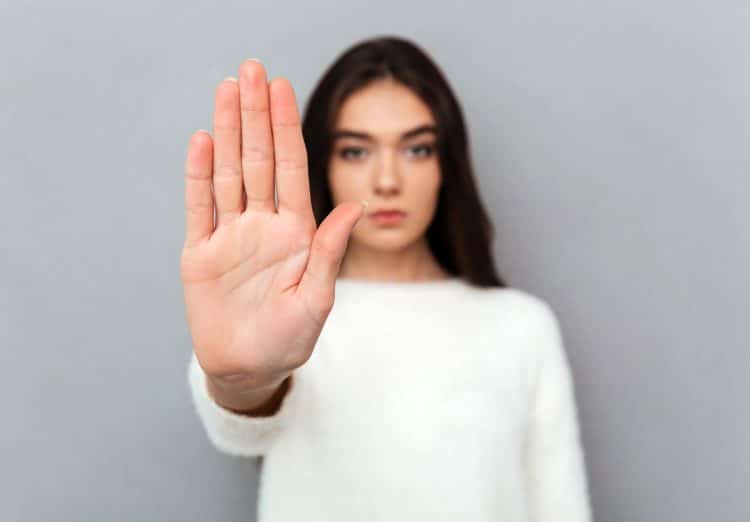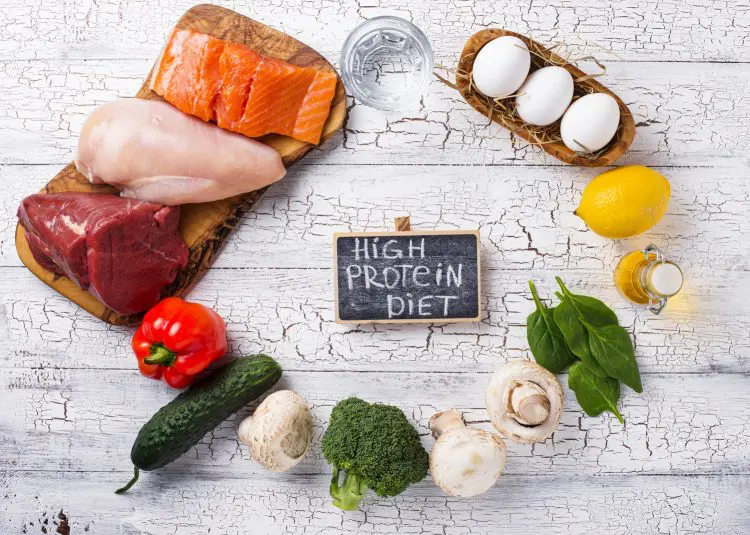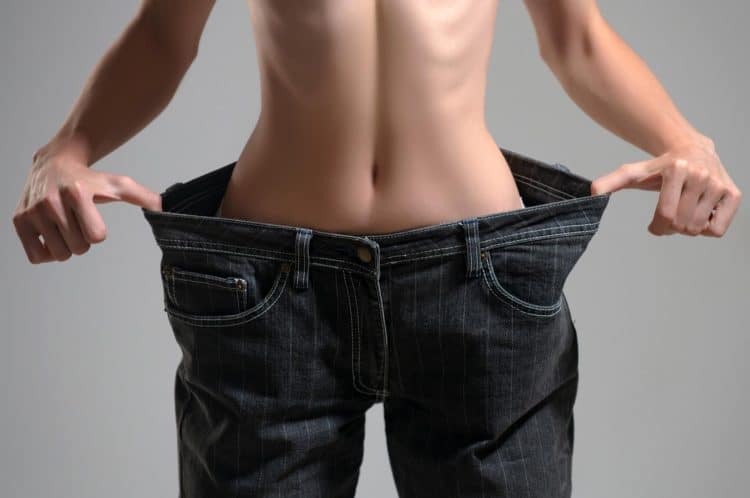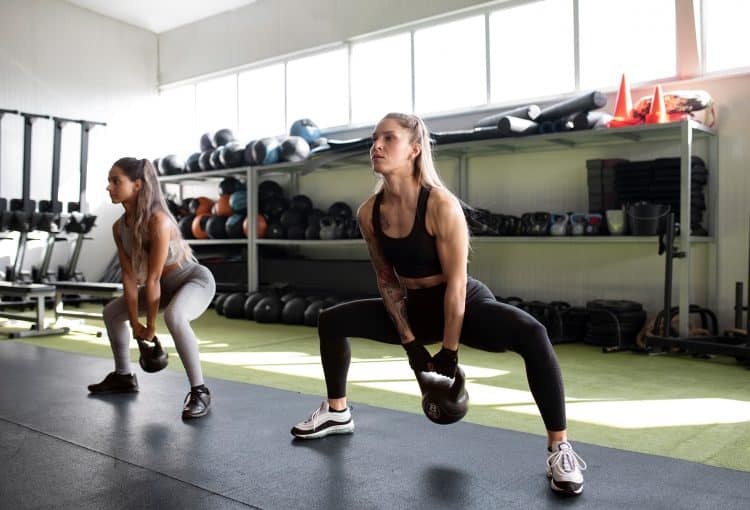Let’s get one thing straight from the outset; not everyone needs or will be able to lose 30 pounds in a month. In fact, for a lot of people, it’s probably too big a challenge. Achieving such a significant weight loss will be hard and far from enjoyable.
That said, it is possible to lose 30 pounds in 30 days, so if that is what you want or need to do, you’re in the right place!
In this article, we reveal the strategies that’ll help you lose those unwanted pounds.
Why You SHOULDN’T Try to Lose 30 Pounds in a Month
Most fitness, nutrition, and health experts agree that weight loss is best achieved by losing about 1-2 pounds a week, or 4-8 pounds a month. Slow, steady weight loss is relatively easy and sustainable. And, once you’ve lost the desired amount of weight, you shouldn’t have too much difficulty keeping it off.

This approach to losing weight typically involves moderate calorie restriction and modest amounts of exercise. As such, it won’t be too impactful on your life.
Level Up Your Fitness: Join our 💪 strong community in Fitness Volt Newsletter. Get daily inspiration, expert-backed workouts, nutrition tips, the latest in strength sports, and the support you need to reach your goals. Subscribe for free!
In contrast, losing 30 pounds in a month requires MUCH more effort. For 30 days straight, you’ll need to commit to a strict diet and exercise regime. You’ll need to forgo pleasures like eating out, sweets and soda, and rest days.
For one month, you’ll need to become obsessed with your weight loss journey. There is no room for moderation! Hunger and tiredness will be your constant companions, and you can expect to become more than a little obsessed with food.
Because of this, the 30 pounds in a month weight loss challenge is not for everyone.
If you can’t stick to a diet, often miss workouts, lack motivation, have any underlying medical conditions, suffer from an eating disorder, or are pregnant, this is not the plan for you.
Also, it’s worth noting that while you WILL lose fat during the coming month, you’ll also lose muscle mass, and some of the weight you shed will be water. We mention this not to put you off trying to lose 30 pounds in 30 days but to temper your expectations and explain the realities of rapid weight loss.
So, while losing 30 pounds in a month is not for everyone, if you are prepared to put in the work and are a viable candidate, we’re here to help you achieve your goal.
Reasons to Lose 30 Pounds in a Month
While there are plenty of reasons NOT to attempt to lose 30 pounds in a month, there are several compelling reasons to accept this challenge:
You need a weight-loss jump start
Slow, steady weight loss might be healthy, sustainable, and relatively easy, but it’s not exactly exciting. Losing a lot of weight quickly can be very motivating.
After one month of strict dieting and intense exercise, you’ll be more than ready to ease up and transition into a more sustainable, long-term weight loss plan. The first 30 days will provide you with momentum and make the rest of your weight loss journey feel much easier.
You need to lose weight for a big event
Have you been invited to your ex-girlfriend’s or ex-boyfriend’s wedding? Are you going to your 10-year school reunion? Have you got a beach vacation coming up? Do you need to be a certain weight for an employment-related fitness assessment?
Whatever the reason, losing weight for a big event could be all the reason you need to drop 30 pounds in a month. Put the date on your calendar and count back 30 days. That’s when you need to start your weight loss challenge.
For the challenge and satisfaction
Modern life is not especially challenging. That’s why a lot of adventurous types climb mountains, explore deep caves, jump from planes, or look for other ways to test themselves and feel alive.
While losing 30 pounds in a month probably won’t give you much of an adrenalin rush, it’ll still be hard and requires determination and commitment. You’ll need to dig deep to achieve your goal.
So, if you are looking for a challenge but don’t want to risk your life climbing a mountain, try losing 30 pounds in 30 days. Assuming you can stick to the plan, you should feel great satisfaction when you reach the end of the month.
9 Tips For Losing 30 Pounds In 30 Days
So, you’ve decided you want to lose 30 pounds in 30 days. Good for you! These are the strategies you’re going to use to achieve your weight loss goal:
1. Create a significant calorie deficit
Body fat is unused, stored energy, and we measure that energy in calories. Whenever you eat more food than your body needs, the excess calories are converted to and then stored as fat. The greater the calorie surplus, the faster you’ll gain body fat.
So, to lose that fat, you need to create a calorie deficit, meaning you eat less and exercise more. This deficit will force your body to burn stored fat for fuel.
It’s generally accepted that a pound of body fat is equal to around 3,500 calories, so to lose 30 pounds in a month, you need a deficit of 3,500 per day. That’s the math, right?
However, for many people, such a huge deficit is impossible. It would involve exercising for several hours a day and eating virtually nothing. Even the toughest of the tough would struggle to maintain such a strict regimen.
Instead, you should aim for a 30% deficit, meaning you eat about two-thirds of the number of calories required to maintain your current weight.
This is still a big undertaking and means you a) will have to significantly lower your food intake and b) significantly increase your daily calorie expenditure.
To determine the number of calories you need to eat per day, use this calorie deficit calculator. Select the aggressive weight loss option to ensure you lose weight as fast as possible.

2. Track your calories
While calorie counting is not 100% accurate, it’s the only way to ensure that you have created a calorie deficit. Get into the habit of weighing and measuring everything you eat and consuming 30% less than the number of calories you’d otherwise need to maintain your weight.
Use an online calorie tracker or an app on your phone. Store your favorite meals to save time in the future.
Remember to record all foods and calorie-containing beverages. Be as precise as you can be and 100% honest, as even small errors could affect your progress.
3. Exercise every day
While you can lose weight without exercise, there is no way you’ll lose 30 pounds in a month if you don’t work out. Combined with your 30% calorie deficit, exercise will:
- Increase your calorie expenditure
- Minimize muscle loss
- Improve muscle tone
- Help with nutrient partitioning and glucose tolerance
- Provide you with a small amount of leeway on your diet
Ultimately, any kind of exercise burns calories, so you should choose the type of workout you enjoy most and are able to do every day. Cardio and strength training are good options, and there are plenty of different ways to do these workouts, so you should be able to find activities that you can do daily.
For cardio, you can jog, run, cycle, row, or do group exercise classes. You can also choose or alternate between low-intensity steady state (LISS) and high-intensity interval training (HIIT) to keep your workouts varied and interesting.
For strength training, you can do bodyweight, barbell, dumbbell, or kettlebell exercises. You can also choose between full-body workouts or a split routine.
Regardless of which options you choose, you need to commit to working out for at least one hour per day, seven days a week. Try to avoid doing the same activities every day, as that could lead to boredom and even overuse injuries.
In addition, look for ways to enhance your calorie expenditure, such as:
- Fasted workouts (exercise on an empty stomach)
- Wearing a weighted vest
- Working out twice a day (two 45-minute workouts instead of one 60-minute workout)
You don’t have to train with 100% intensity all the time. It’s OK to have the occasional easy workout if you are feeling tired. However, you must do some form of physical activity every day to keep the fat-burning furnaces burning hot.
4. Walk, walk, and walk some more!
Walking is probably one of the easiest ways to lose weight, and the more you walk, the more weight you’ll lose. Compared to more intense workouts, walking is not a great calorie burner. However, you can do a lot of it, and it’s not especially tiring. As such, it makes a great addition to your daily hour plus of structured exercise.
You don’t need any special equipment to benefit from walking, and you can do it almost anywhere and anytime. It can even be relaxing and enjoyable.
To lose 30 pounds in a month, you need to try and walk about 3-4 miles per day, every day of the week, for 30 days straight. Feel free to extend this and walk further at weekends.
For most people, 3-4 miles of walking will take about an hour. You don’t need to do this in one session and can break it down into a couple of shorter walks per day if that’s more convenient.
However, 30 days of walking is non-negotiable. Walking every day will save you from having to cut your calories even more drastically or spending more time working out.
5. Do intermittent fasting
One of the easiest ways to reduce your calorie intake is to eat fewer meals per day. This is called intermittent fasting. In simple terms, you skip breakfast, push your lunch back a couple of hours, and just eat two meals per day. This is known as an 18:6 fast – you avoid eating for 18 hours and then eat two meals within the last six hours of the day.
Level Up Your Fitness: Join our 💪 strong community in Fitness Volt Newsletter. Get daily inspiration, expert-backed workouts, nutrition tips, the latest in strength sports, and the support you need to reach your goals. Subscribe for free!
Intermittent fasting usually leads to rapid weight loss. It may even be good for you as it promotes something called autophagy, which is the removal of old bodily cells and the production of new, healthy cells.
Fasting also improves nutrition partitioning and glucose tolerance, which helps ensure that the food you eat ends up in your muscles and not your adipose (fat-storing) cells.
However, for intermittent fasting to work, you MUST resist the temptation to overeat when you break your fast. A massive late lunch and dinner, or unplanned snacks, will undo the benefits of fasting. For fasting to work, your post-fast meals must be light and healthy and keep you within your daily calorie target.
6. Go keto
Keto is short for the ketogenic diet, which is a very low-carb eating plan that works well for short-term weight loss.
With keto, you mostly eat protein and fats and limit your carb intake to 50 grams or less per day. Without carbs for fuel, your body is more likely to burn fat.
Keto also leads to significant water loss. As your body releases stored carbohydrates from your muscles and liver, it also releases water, and you’ll pee away several extra pounds this way. That’s why keto dieters often lose ten or more pounds in the first two weeks of their diet.
Ketogenic meals are based on protein, healthy fats, and non-starchy vegetables. For example, you might have grilled skinless chicken, a green salad, and an olive oil dressing. Or, for breakfast, you might have 3-4 eggs and half an avocado.
While you can lose weight while eating carbs, you’ll probably find it easier if you cut down on bread, rice, pasta, etc., and follow the ketogenic diet instead.
7. Get adequate protein

Going keto means you should eat plenty of protein. Still, you need to pay attention to your protein intake to ensure you are consuming enough. Eating plenty of protein will help you on your weight loss journey. The effects of dietary protein during a weight loss diet include:
- Preservation of muscle mass
- Faster recovery after exercise
- Increased satiety
- Elevated metabolic rate
Aim to eat between 1.5 to 2.0 grams of protein per kilogram of body weight, or about 0.7 to 1.0 grams per pound. This may or may not require using a protein supplement, such as whey protein.
Related: Protein Intake Calculator
8. Sleep more
One of the most important things you can do to speed up weight loss is also one of the easiest – sleep. You burn calories while you sleep, and it’s critical for muscle growth and repair, recovery from exercise, fat burning, and your general health.
Try to get at 7-9 hours of sleep per night, even if that means going to bed earlier. Lack of sleep has been shown to:
- Decrease fat burning
- Increase muscle breakdown
- Decrease energy
- Reduce dietary compliance
- Reduce motivation for exercise
- Decrease anabolic (muscle building) hormone production
- Increase insulin resistance
Exercising daily and eating less will probably leave you feeling tired, so that means sleep is doubly important during your 30 pounds in 30 days weight loss challenge. Plus, you can’t eat while you are sleeping!
Read more about the importance of sleep and weight loss here.
9. Drink a LOT of water and reduce your salt intake
Water is your rapid weight loss, friend. Water contains no calories, and yet it’s surprisingly filling. In addition, drinking water actually burns calories – albeit in relatively small amounts. Try to drink at least 64 ounces of water a day.
Also, and somewhat counterintuitively, drinking a lot of water can help you lose excess water weight. When you drink a lot, your body stops storing water and excretes it more freely. As such, you won’t hold as much water in your cells, and you’ll weigh less. Water is heavy stuff, and one liter is equal to about a kilo or 2.2 pounds.
In contrast, dietary salt (sodium chloride) is hydrophilic and increases water storage. Therefore, you should avoid salty processed foods and adding too much salt to your meals if you want to minimize water weight.
FAQs
Got a question about losing 30 pounds in a month? We’ve got answers!
1. Why am I not losing weight?
The most common reasons for not losing weight are:
- You are eating too much
- You aren’t exercising enough
- A combination of the above
If you are not losing weight, go back and recalculate your calorie needs, work out your 30% weight loss deficit, and commit to intermittent fasting and the keto diet. Then make sure you are doing an hour of cardio and/or strength training each day and walking 2-3 miles.
If you are still not losing weight, you should probably visit your doctor as there may be an underlying medical condition affecting your progress. However, in 99-percent of cases, it’s diet and exercise that are the problem.
2. I’m hungry and tired all the time – is this normal?
Exercising more while eating a lot less than usual will undoubtedly leave you feeling tired and hungry. That’s part and parcel of trying to lose 30 pounds in 30 days.
The good news is that you’re only going to feel this way for a few weeks, so you should be able to knuckle down and tough it out. Be determined!
However, you can ward off hunger AND boost your energy by drinking water, unsweetened green tea, and plain black coffee. Diet soda can also be useful but take care if you are sensitive to artificial sweeteners.
3. Will I definitely lose 30 pounds in 30 days if I follow this advice?
While you COULD lose 30 pounds in a month, there are no guarantees. Your actual weight loss will depend on your diet and exercise compliance, your genetics, and how much weight you’ve got to lose. People who are very overweight tend to lose weight faster than those who are already close to their ideal weight.
The only way to find out if you can lose 30 pounds in 30 days is to try. Give it your best shot!
4. Are there any supplements that can help me lose weight faster?
The key to losing weight is creating a calorie deficit by eating less and exercising more. Without a deficit, weight loss is doubtful. That said, there are a few supplements that may be helpful and could enhance your results.
Options include:
5. I don’t have time to work out for an hour a day – what should I do?
If you don’t have time for hour-long workouts, you need to do shorter, more intense forms of exercise. If you hustle, you can get a decent workout in 20-30 minutes, but you WILL have to work extra hard to burn a significant number of calories.
The next time you are short of time, try this full-body workout. It’s over and done in 30-minutes, and you can do it at home.
- Jump rope for five minutes to warm up.
- Do as many laps of 5 pull-ups, 10-push-ups, and 15 air squats as possible in 20 minutes. 10 laps is a good target, but 15 is better!
- Jump rope for five minutes to cool down.
Related: Two-exercise workout for time-pressed bodybuilders
Really short on time? Take a look at these Tabata workouts, many of which take 10 minutes or less.
6. Is it safe to lose 30 pounds in a month
Safe is a relative term. While losing 30 pounds in 30 days is going to be a challenge, if you are fit and healthy, it shouldn’t cause you any harm. That said, you’ll probably experience some headaches, hunger, fatigue, mood swings, brain fog, and intense hunger. You’ll also lose muscle mass and may suffer muscle cramps and dehydration.
That said, if you run into trouble (feel unwell or unable to continue), you can just stop and return to a more moderate workout and eating plan.
However, such extreme weight loss is not for everyone, and you do it at your own risk. If you are in any doubt, a less intense weight loss plan is probably best.
7. The month is finished – what next?
Firstly, congratulations on completing your challenge. Whether you lost 30 pounds or not, dieting and exercising for a month straight is a significant achievement. However, now you need to maintain your commitment to ensure that you don’t regain all the weight you’ve just worked so hard to lose.
That doesn’t mean you need to keep following such a strict plan. Still, if you want to avoid weight regain, you do need to continue eating healthily and exercising regularly.
Increase your calorie intake to just 300-500 calories below maintenance and introduce a couple of rest days per week into your workout schedule. You can also move away from intermittent fasting and keto and adopt a more forgiving diet if you wish.
However, resist the temptation to celebrate your success with a week of binge eating. Too many cheat meals could completely undo your month of hard work. Instead, enjoy a couple of small treat meals and snacks, but resist the temptation to go overboard.
Related: How to Stop Cheat meals Ruining Your Diet
How to Lose 30 Pounds in A Month – Wrapping Up
Losing 30 pounds in 30 days will not be easy. In fact, the odds of success are very much stacked against you. You’ll need to slash your food intake and commit to daily workouts, suffering hunger and tiredness along the way.
But, if you can stick to the plan, you could weigh 30 pounds less this time next month. You won’t know unless you try!
So, if you like a challenge and are ready to work hard, use the information in this guide to see if you have the grit to lose 30 pounds in one month.
Next read: How to Lose 20 Pounds in a Month — Explained!













